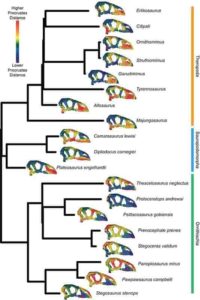
From emus to woodpeckers, modern birds show remarkable diversity in skull shape and size, often hypothesized to be the result of a sudden hastening of evolution following the mass extinction that killed their non-avian dinosaur cousins at the end of the Cretaceous 66 million years ago. But this is not the case according to a study by Ryan Nicholas Felice at University College London, publishing August 18, 2020 in the open-access journal PLOS Biology. In the most detailed study yet of bird skull morphology, Felice and an international team of researchers show that the rate of evolution actually slowed in birds compared to non-avian dinosaurs.
The researchers used high-dimensional 3-D geometric morphometrics to map the shape of 354 living and 37 extinct avian and non-avian dinosaurs in unprecedented detail and performed phylogenetic analyses to test for a shift in the pace of evolution after the origin of birds. They found that all regions of the skull evolved more rapidly in non-avian dinosaurs than in birds, but certain regions showed rapid pulses of evolution in particular lineages.
For example, in non-avian dinosaurs, rapid evolutionary changes in the jaw joint were associated with changes in diet, while accelerated evolution of the roof of the skull occurred in lineages that sported bony ornaments such as horns or crests. In birds, the most rapidly evolving part of the skull was the beak, which the authors attribute to adaptation to different food sources and feeding strategies.
The authors say that overall slower pace of evolution in birds compared to non-avian dinosaurs calls into question a long-standing hypothesis that the diversity seen in modern birds resulted from rapid evolution as part of an adaptive radiation following the end-Cretaceous extinction event.
Reference:
Felice RN, Watanabe A, Cuff AR, Hanson M, Bhullar B-AS, Rayfield ER, et al. (2020) Decelerated dinosaur skull evolution with the origin of birds. PLoS Biol 18(8): e3000801. doi.org/10.1371/journal.pbio.3000801
Note: The above post is reprinted from materials provided by Public Library of Science.










